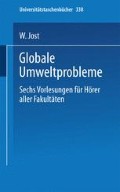Zusammenfassung
Versuchen wir uns nochmals Rechenschaft zu geben über die globalen Probleme bei der Verschmutzung der Atmosphäre und der Gewässer, über gewonnene oder noch zu suchende Lösungen, über die Bedeutung der Grundlagenforschung dabei; schließlich möchte ich an historische bzw. archäologische und prähistorische Kenntnisse und Erkenntnisse erinnern, die zwar den meisten von uns geläufig, meist aber nicht gegenwärtig sind oder vergessen werden.
Access this chapter
Tax calculation will be finalised at checkout
Purchases are for personal use only
Preview
Unable to display preview. Download preview PDF.
Reference
Vergl. Kellogg, W.W., Cadle, R.D., Allen, E.R., Lazarus, A.L. und Martell, E.A., „Sulfur Cycle“, Science 175, No. 4022, 587–596 (1972). Vergl. ferner in diesem Buch S. 73 ff.
Als besonders schwer zu beseitigende Rückstände in der Industrie sind Salzrückstände zu betrachten (vergl. den früher zitierten Vortrag von K. Winnacker, S. 3).
Vergl. Borlaug, Norman E., Träger des Friedensnobelpreises [nach BAYER-Berichte 30, 20 ff (1973)]
nach Chemical and Engineering News 10 Jan., 1972 S. 17/18
Vergl. Chemical and Engineering News, 24 May, 1971, S. 12. Ferner Johnston, H.L. et al., Atmospheric Chemistry and Physics, Project Clean Air 4, UC, Sep. 1 (1970)
Vergl. den Bericht: Atmospheric Carbon Dioxide and Aerosols: Effects of Large Increases on Global Climate, Science 173, No. 3992, 138-141 (1971), by Rasool, S.I. and Schneider, S.H., Institute for Space Studies, Goddard Space Flight Center, NASA, N.Y. 10025.
K. Wagener und H. Förstel (Jülich): „Relaxation Phenomena in the Biological Carbon Cycle under Conditions of Variable Atmospheric CO2-Content“. 14C ist das in der Atmosphäre gebildete instabile, schwere Kohlenstoffisotop, das zur Altersbestimmung kohlenstoffhaltiger Stoffe dient. Es wird in der Atmosphäre laufend gebildet und verschwindet gleichzeitig durch Einbau in Pflanzen, Auflösung im Meer, Abscheidung in Sedimenten.
M.S. Baxter und A. Walton, Proc.Roy.Soc, London A 318, 213–230 (1970)
Chemical and Engineering News vom 3. Juli 1972, S. 2
McConell J.C., McElroy, M.B. und Woesey, S.C., Nature 233, 187/8 (1971)
„Inadvertent Climate Modification, Report of the Study of Man’s Impact on Climate (SMIC)“, Sponsored by MIT, S. 242 (Cambridge, Mass. 1971).
„Man’s Impact on the Global Environment, Report of the Study of Critical Environmental Problem (SCEP)“, MIT Press, S. 205 (1970).
„Inadvertent Climate Modification, Report of the Study of Man’s Impact on Climate (SMIC)“, S. 278 (Cambridge, Mass. 1971). Diese Verbindung ist dem Laien, wegen ihrer narkotisierenden Wirkung unter dem Namen „Lachgas“ bekannt.
Hierzu gibt es neuere Messungen von der „Concorde“
„International Herald Tribune“ von 27.9.1971
Lewis, Anthony (London) Jan. 13, 1972 (New York Times)
Weisskopf, Victor F., „Die Bedeutung der Naturwissenschaft“, Science 176, No. 4031, 138/9 (April 1972)
„L’homme avant l’écriture“ herausgegeben von Andrè Varagnac, aus einem Kapitel des Herausgebers, S. 60 ff (Paris 1959).
Vergl. Cole, Sonia „The Neolithic Revolution“, British Museum, S. 7 (1959)
Dimbleby, D.G.W. „The Impact of Early Man on his Environment“, aus: „Population and Pollution“, ed. by P.R. Cox and J. Peel, Proceedings of the Eighth Annual Symposium of the Eugenic Society, London, 1971 (London 1972) p. 7 ff. (D.G.W. Dimbleby: Department of Human Environment, Institute of Archaeology, University of London, England.)
Wie anderswo erwähnt, wirft man heute im Winter in den Vereinigten Staaten auf 9 Millionen km2 ebenso viele Tonnen Salz, im Mittel 1 g je m2 je Jahr! In dem viel dichter besiedelten Deutschland sollte man diese Umweltverschmutzung nicht ignorieren!
Wie es auch noch die Ansicht der Bibel ist.
Grin, Alexander M. (Inst. f. Geographie der Akad. Wiss., Moskau): Wasserhaushalt der russischen Ebene, in: Umschau 72, Heft 17, 551-554 (1972).
Brothwell, Don, „The Question of Pollution in Earlier and Less Developed Societies“, Sub-Department of Anthropology, British Museum (Natural History), London, England.
Im übersetzten Text steht „um-“, was aber wohl nur ein Druckfehler zu sein scheint. Nach dem Zusammenhang kann es sinngemäß nur „un-“ heißen!
D.M. Dixon, Department of Egyptology, University College, London, England „Population, Pollution and Health in Ancient Egypt“
Von hier aus gesehen, erscheint die Einführung der Technik des Kohlebergbaues also durchaus als umweltfreundliche technische Neuerung!
Leach, E.R., Provost, King’s College, Cambridge, England, „Anthropological Aspects: Conclusion“
Rights and permissions
Copyright information
© 1974 Dr. Dietrich Steinkopff Verlag, Darmstadt
About this chapter
Cite this chapter
Jost, W. (1974). Problematik in historischer Sicht. In: Globale Umweltprobleme. Uni-Taschenbücher, vol 338. Steinkopff, Heidelberg. https://doi.org/10.1007/978-3-642-95951-6_5
Download citation
DOI: https://doi.org/10.1007/978-3-642-95951-6_5
Publisher Name: Steinkopff, Heidelberg
Print ISBN: 978-3-7985-0377-9
Online ISBN: 978-3-642-95951-6
eBook Packages: Springer Book Archive

